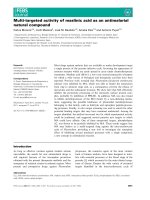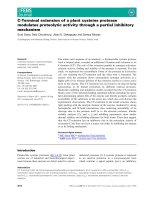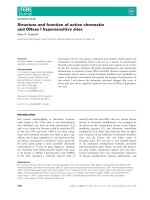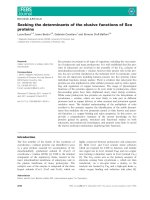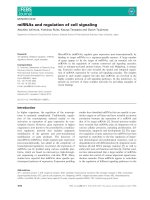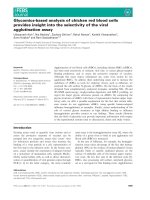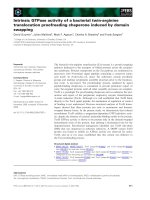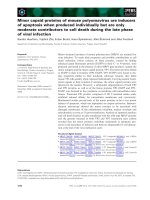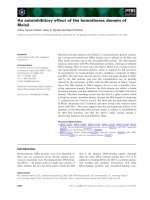Tài liệu Báo cáo khoa học: Prion protein library of recombinant constructs for structural biology docx
Bạn đang xem bản rút gọn của tài liệu. Xem và tải ngay bản đầy đủ của tài liệu tại đây (131.35 KB, 9 trang )
Prion protein library of recombinant constructs for
structural biology
Simone Hornemann*
,
à, Barbara Christenà, Christine von Schroetter, Daniel R. Pe
´
rez and Kurt
Wu
¨
thrich
Institute of Molecular Biology and Biophysics, ETH Zurich, Switzerland
Expression of the prion protein (PrP) in its ‘cellular
form’ (PrP
C
) in healthy organisms is intimately related
to susceptibility to transmissible spongiform encephal-
opathies, such as scrapie in sheep, bovine spongiform
encephalopathy, chronic wasting disease in deer, and
Creutzfeldt–Jakob disease in humans [1]. Transmissible
spongiform encephalopathies are related to the conver-
sion of PrP
C
to a protease-resistant b-sheet-rich ‘scrapie
form’ [2]. The gene encoding PrP has been sequenced
[3,4], and post-translational modifications, such as
cleavage of N-terminal and C-terminal signal sequences
during import into the endoplasmic reticulum, forma-
tion of a disulfide bond, N-linked glycosylation at two
sites, and addition of a C-terminal glycosylphosphat-
idylinositol anchor, have been described [5,6]. Structure
determinations by NMR spectroscopy have shown that
PrP
C
s from mammals, birds, reptiles and amphibians
all possess the same molecular architecture, consisting
of a flexibly extended 100 residue N-terminal tail and a
globular C-terminal domain of similar size [7–14].
Keywords
NMR structure determination; prion protein
plasmid library; prion protein structural
biology; recombinant prion proteins;
transmissible spongiform encephalopathies
Correspondence
K. Wu
¨
thrich, Institute of Molecular Biology
and Biophysics, ETH Zurich, CH-8093
Zurich, Switzerland
Fax: +41 44 633 1151
Tel: +41 44 633 2473
E-mail:
Website: />groups/wuthrich_group
*Present address
Institute of Neuropathology, Universita
¨
ts-
Spital Zurich, Switzerland
àThese authors contributed equally to this
work
(Received 23 December 2008, revised 12
February 2009, accepted 13 February 2009)
doi:10.1111/j.1742-4658.2009.06968.x
A survey of plasmids for 51 prion protein constructs from bank vole, cat,
cattle, chicken, dog, elk, ferret, frog, fugu, horse, human, pig, sheep, turtle,
and wallaby, and for 113 mouse prion protein constructs and variants
thereof, is presented. This includes information on the biochemistry of the
recombinant proteins, in particular on successful and unsuccessful expres-
sion attempts. The plasmid library was generated during the past 12 years
in the context of NMR structure determination and biophysical character-
ization of prion proteins in our laboratory. The plasmids are now available
for general use, and are distributed free of charge to not-for-profit
institutions.
Abbreviations
hPrP, human prion protein; mPrP, mouse prion protein; PrP, prion protein; PrP
C
, cellular form of prion protein.
FEBS Journal 276 (2009) 2359–2367 ª 2009 The Authors Journal compilation ª 2009 FEBS 2359
As part of a major project on PrP structural biology
pursued over the past 12 years, our laboratory has
generated recombinant constructs of the mature forms
of PrPs from a variety of mammalian and nonmamma-
lian species, and of partial sequences thereof. In addi-
tion, designed variants of mouse PrP (mPrP) and
human PrP (hPrP) were prepared; these include mimics
of most of the pathological mutations identified in
hPrPs and a selection of variant PrPs observed in
other species. Some of these constructs have previously
been described in connection with structural studies of
PrP
C
s by NMR spectroscopy [7,9–24], and in reports
on physical–chemical studies, such as transformation
into insoluble fibrils [25]. A large number of additional
PrP constructs have been cloned, and in part also
expressed and purified for extensions of and as internal
controls in our studies, without being explicitly
described in earlier publications. In view of the contin-
ued widespread interest in exploring the role of the
PrP in health and disease (see above), and considering
that the PrP constructs generated in our laboratory
could be of use to others for functional or further
structural studies, this article presents a survey of all
the PrP plasmids available from us upon request, and
provides a concise account of our experience with the
biochemistry of recombinant PrPs, in particular of suc-
cessful as well as unsuccessful expression attempts.
Results and Discussion
This section presents listings of plasmids that encode
the mature forms, devoid of the signal sequences, of
natural and modified PrPs from a variety of mamma-
lian and nonmammalian species, which have been pre-
pared for studies on the structure and function of
PrP
C
, and which are now available upon request for
use elsewhere. The data are collected in Tables 1 and
2, and at the end of this section we provide informa-
tion on where the plasmids can be obtained. All plas-
mids were designed for protein expression in bacterial
cultures and not for expression in mammalian cells.
Table 1 lists plasmids encoding tetrapod and fish
PrP sequences. This includes columns containing the
binomial name of the species, the accession number of
the sequence in the NCBI protein database, the con-
struct length, and information on the biochemical
investigations performed. The summary statements in
the last column have the following meaning: ‘NMR
structure solved’ indicates that stable solutions con-
taining about 1 mm concentrations of
13
C,
15
N-labeled
protein were obtained from cultures in minimal
medium; the Protein Data Bank (PDB) entry code and
literature references are given. ‘NMR structure
determination in progress’ has the same meaning,
except that PDB deposition and publication are still in
progress. For all other constructs no NMR structure
determination has been performed, either because this
would not have been of interest in the context of the
ongoing projects, or because of the lack of sufficient
amounts of purified protein. The indications of the
yields of expression and reconstitution for these con-
structs are self-explanatory, whereby the constructs
with high yields of natively refolded soluble protein
can be considered as promising candidates for future
NMR structure determinations, or for other studies
that require milligram amounts of pure protein with
long-term stability of the PrP
C
form. The term ‘no
expression data’ is used if either the initial expression
trials were unsuccessful, or initial successful expression
was not followed up, or no expression trials have been
performed.
For most species, two PrP plasmids are listed: a first
one encoding the polypeptide corresponding to the
‘full-length’ mature PrP
C
, usually comprising residues
23–231, and a second one encoding a C-terminal frag-
ment spanning residues 121–231 (see Scha
¨
tzl et al. [26]
for the numeration used in this article). This C-terminal
fragment forms a globular domain both as part of the
full-length sequence and in the isolated form, and there-
fore constructs of the isolated C-terminal globular
domain have been used for NMR structure determina-
tions with many of the species [7,9–14,19,20,23,24].
Actually, structure determinations of the full-length
protein have been performed only for the PrPs from
mouse (Table 2), cattle, and humans. For hPrP, Table 1
also lists a number of designed variants of hPrP(121–
230), most of which have been inspired by natural varia-
tions in mammalian PrP amino acid sequences. Human
PrP fragments of variable lengths have been used to
study the minimal length of the amino acid sequence
that is needed for stability of the globular domain fold
(R. Zahn, C. von Schroetter & K. Wu
¨
thrich, unpub-
lished results). Finally, the human doppel protein has
also been included in Table 1.
Mouse PrP was used as a reference in most of our
projects. For example, whenever the PrP
C
structure
from a different species displayed significant local dif-
ferences when compared to mPrP, selected single
amino acid replacements, or combinations thereof,
were introduced into mPrP to search for the sequence
features that cause the local variations in the three-
dimensional structure. A large number of constructs
were thus derived from the mPrP sequence, and these
are given in Table 2, where they are listed in order of
decreasing chain length. Overall, Table 2 is dominated
by a large number of variants of mPrP(121–231),
Plasmid library of prion proteins S. Hornemann et al.
2360 FEBS Journal 276 (2009) 2359–2367 ª 2009 The Authors Journal compilation ª 2009 FEBS
Table 1. List of plasmids encoding the sequence of the mature cellular form of the prion protein from a variety of species and truncated
variants thereof, and of human doppel. The protein accession number refers to the NCBI protein database ().
For the American elk, bank vole, chicken, dog, ferret, pig, sheep, tammar wallaby, and turtle, the reference is for the C-terminal sequence
fragment that forms a globular domain in PrP
C
. pRSET A is a vector obtained from Invitrogen.
Species
Accession
no.
Construct cloned
into pRSET A Comments (PDB)
a
American elk
(Cervus elaphus nelsoni)
AAB94788 ePrP(23–230)
b,c
High-yield expression, high yield of
refolded soluble protein
ePrP(121–230)
b,c
NMR structure solved (1XYW) [12]
Bank vole (Clethrionomys glareolus) AAL57231 bvPrP(121–231)
b,c
NMR structure solved (2K56) [14]
Cat (Felis catus) AAS94127 fPrP(23–231)
b,c
High-yield expression, high yield of
refolded soluble protein
fPrP(121–231)
b,c
NMR structure solved (1XYJ) [11]
Cattle (Bos taurus) ABU97893 bPrP(23–230)
b
NMR structure solved (1DX1) [9]
bPrP(90–230)
b
High-yield expression, high yield of
refolded soluble protein
bPrP(121–230)
b
NMR structure solved (1DWZ) [9]
Chicken (Gallus gallus) NP_990796 chPrP(23–225)
b,c
High-yield expression, high yield of
refolded soluble protein
chPrP(121–225)
b,c
NMR structure solved (1U3M) [13]
Dog (Canis familiaris) AAD12061 cPrP(23–231)
b,c
High-yield expression, high yield of
refolded soluble protein
cPrP(121–231)
b,c
NMR structure solved (1XYK) [11]
Ferret (Mustela putorius furo) AAA69022 Ferret PrP (121–231)
b,c
High-yield expression, reconstitution
yielded a nonglobular polypeptide
Frog (Xenopus laevis) AAV54126 xlPrP(90–222)
b,c
NMR structure solved (1XU0) [13]
Fugu (Takifugu rubripes) AAN38988 Fugu-PrP1(298–423)
d
High-yield expression, reconstitution
yielded a nonglobular polypeptide [24]
Horse (Equus caballus) ABL86003 ecPrP(23–231)
b,c
High-yield expression, high yield of
refolded soluble protein
ecPrP(121–231)
b,c
NMR structure determination in progress
Human (Homo sapiens) P04156 hPrP(23–230)
b
NMR structure solved (1QLZ) [10,38]
hPrP(81–230)
b
High-yield expression, high yield of
refolded soluble protein
hPrP(90–230)
b
NMR structure solved (1QM1) [10]
hPrP(96–230) No expression data
e
hPrP(100–230) No expression data
e
hPrP(105–230) No expression data
e
hPrP(110–230) No expression data
e
hPrP(121–230)
b
NMR structure solved (1QM3, 1HJN) [10,20]
hPrP(126–230) No expression data
e
hPrP(130–230)
b
High-yield expression, high yield of
refolded soluble protein
hPrP(135–230) No expression data
e
hPrP(23–222) No expression data
e
hPrP(23–226) No expression data
e
hPrP(121–226)
b
High-yield expression, high yield of
refolded soluble protein
hPrP(121–222) No expression data
e
hPrP(126–219) No expression data
e
hPrP(126–222) No expression data
e
hPrP(126–226) No expression data
e
hPrP[M166C ⁄ E221C](121–230)
b
NMR structure solved (1H0L) [22]
hPrP[M166V](121–230)
b
NMR structure solved (1E1G) [19]
hPrP[S170N](121–230)
b
NMR structure solved (1E1P) [19]
hPrP[I215V](121–230)
b
High-yield expression, high yield of
refolded soluble protein
hPrP[Q217R](121–230) No expression data
e
S. Hornemann et al. Plasmid library of prion proteins
FEBS Journal 276 (2009) 2359–2367 ª 2009 The Authors Journal compilation ª 2009 FEBS 2361
which contain single or multiple amino acid replace-
ments relative to the wild-type sequence. Many of
these sequence variations are located in a surface
epitope formed by the polypeptide segment 165–175,
which forms a loop that connects a b-strand with an
a-helix in PrP
C
, and the polypeptide segment 220–228,
which forms part of a C-terminal a-helix [12,14].
The extremely high variability in both the sequence
and local conformation of this epitope [27,28] has
attracted special interest with regard to the physiologi-
cal role [29–31] and the structural biology of PrP
C
[12,14].
Additional plasmids listed in Table 2 encode full-
length mPrP and constructs containing residues 90–231
or shorter fragments of the mPrP sequence. A selection
of the amino acid replacements studied in mPrP(121–
231) was also introduced into constructs of different
lengths, e.g. to obtain internal controls for their effects
on the three-dimensional structure. Constructs with
amino acid exchanges outside of the globular domain
were used to study the effects of sequence variations
on interactions with membrane mimics, such as deter-
gent micelles (S. Hornemann, C. von Schroetter,
F. F. Damberger & K. Wu
¨
thrich, unpublished results),
or on conformational equilibria. For some of these
projects, the N-terminal fusion tag GB1 [32,33] was
added to the constructs in order to enhance the expres-
sion yield and the solubility of selected mPrP
constructs. Finally, Table 2 also includes the mouse
doppel protein, for which the NMR solution structure
has been determined by Mo et al. [34], and the mouse
Shadoo protein, which has recently been biochemically
characterized [35].
The plasmids listed in Tables 1 and 2 are available
free of charge for use in academic and other not-for-
profit institutions by contacting S. Hornemann at Uni-
versita
¨
tsSpital Zurich, Institute of Neuropathology,
Schmelzbergstr. 12, CH-8091 Zurich, Switzerland (simone.
). We will not be in a position to
entertain requests either for crude cell extracts or for
purified proteins.
Experimental procedures
The procedures used in our laboratory for the cloning,
expression and purification of recombinant PrPs have been
developed mainly with full-length and truncated constructs
of mPrP and hPrP. Here, we present short descriptions of
these procedures as they were applied to prepare the
proteins of Tables 1 and 2 [10,15,18,23,36,37].
mPrP(121–231) from soluble expression in
Escherichia coli periplasmic extracts using the
vector pPrP-CRR
The gene that encodes for mPrP(121–231) was fused to the
bacterial OmpA signal sequence for secretory periplasmic
expression, yielding the expression vector pPrP-CRR
Table 1. (Continued)
Species
Accession
no.
Construct cloned
into pRSET A Comments (PDB)
a
hPrP[E219Q](121–230)
b
High-yield expression,
high yield of
refolded soluble protein
hPrP[R220K](121–230)
b
NMR structure solved
(1E1U) [19]
Q9UKY0
f
hDpl(24–152)
b,f
NMR structure solved (1LG4) [21]
Pig (Sus scrofa) AAA92862 scPrP(23–231)
b,c
High-yield expression, high yield of
refolded soluble protein
scPrP(121–231)
b,c
NMR structure solved (1XYQ) [11]
Sheep (Ovis aries) AAC78726 ovPrP[Q168H](121–231)
b,c
NMR structure solved (1XYU) [11]
ovPrP[Q168R](121–231)
b,c
NMR structure solved (1Y2S) [11]
Tammar wallaby
(Macropus eugenii)
AAT68001 twPrP(121–230)
b,c
NMR structure determination in progress
twPrP(121–235)
b,c
High-yield expression, reconstitution
yielded a nonglobular polypeptide
Turtle (Trachemys scripta) CAB81568 tPrP(23–225)
b,c
High-yield expression, high yield of
refolded soluble protein
tPrP(121–225)
b,c
NMR structure solved (1U5L) [13]
a
Survey of the protein biochemistry; the PDB () entry is indicated in parentheses, where applicable.
b
Expression and
purification as described in Zahn et al. [10,18].
c
Purification as described in Lysek & Wu
¨
thrich [23].
d
Numeration according to Fugu PrP1
[39].
e
Either initial expression attempts were not successful, or successful expression was not followed up, or no expression trials were
started.
f
Human doppel protein.
Plasmid library of prion proteins S. Hornemann et al.
2362 FEBS Journal 276 (2009) 2359–2367 ª 2009 The Authors Journal compilation ª 2009 FEBS
Table 2. List of plasmids encoding the sequence of the mature cellular form of mPRP (accession number AAA39997) and truncated forms
and designed variants thereof, and of mouse doppel and Shadoo protein constructs. Protein accession numbers refer to the NCBI database
(). pRSET A is a vector obtained from Invitrogen. mPrP(23–231) is also available in the vector pRBI-PDI-T7, and
mPrP(121–231) in the vector pPrP-CRR (see Experimental procedures).
Segment Construct cloned into pRSET A Comments (PDB)
a
23–231 mPrP(23–231)
b,c,d
NMR structure solved [16]
mPrP[K110I ⁄ H111I](23–231)
c,d
High-yield expression, high yield of refolded soluble protein
mPrP[A113V ⁄ A115V ⁄ A118V](23–231)
c,d
High-yield expression, high yield of refolded soluble protein
mPrP[D167S](23–231)
c,d
High-yield expression, high yield of refolded soluble protein
mPrP[D167S ⁄ N173K](23–231)
c,d
High-yield expression, high yield of refolded soluble protein
mPrP[Y169G ⁄ S170N ⁄ N174T](23–231)
c,d,e
High-yield expression, high yield of refolded soluble protein
mPrP[S170N](23–231)
c,d
High-yield expression, high yield of refolded soluble protein
mPrP[S170N ⁄ N171G ⁄ N174T](23–231) No expression data
f
mPrP[S170N ⁄ N174T](23–231)
c,d
High-yield expression, high yield of refolded soluble protein
mPrP[Y225A](23–231) No expression data
f
mPrP[Y225A ⁄ Y226A](23–231)
c,d
High-yield expression, high yield of refolded soluble protein
mPrP[Y226A](23–231) No expression data
f
90–231 mPrP(90–231)
c,d
High-yield expression, high yield of refolded soluble protein
GB1-mPrP(90–231)
c,d,g
High-yield expression, high yield of refolded soluble protein
mPrP[K110I ⁄ H111I](90–231)
c,d
High-yield expression, high yield of refolded soluble protein
GB1-mPrP[K110I ⁄ H111I](90–231)
g
No expression data
f
mPrP[H111A ⁄ A117V](90–231) No expression data
f
mPrP[A113V ⁄ A115V ⁄ A118V](90–231)
c,d
High-yield expression, high yield of refolded soluble protein
GB1-mPrP[A113V ⁄ A115V ⁄ A118V](90–231)
g
No expression data
f
mPrP[A117V](90–231)
c,d
High-yield expression, high yield of refolded soluble protein
mPrP[A117V ⁄ M129V](90–231)
c,d
High-yield expression, high yield of refolded soluble protein
mPrP[D167S](90–231)
c,d
High-yield expression, high yield of refolded soluble protein
mPrP[D167S ⁄ N173K](90–231)
c,d
High-yield expression, high yield of refolded soluble protein
mPrP[Y169A](90–231)
c,d
High-yield expression, high yield of refolded soluble protein
mPrP[Y169G ⁄ S170N ⁄ N174T](90–231)
c,d,e
High-yield expression, high yield of refolded soluble protein
mPrP[S170N](90–231)
c,d
High-yield expression, high yield of refolded soluble protein
mPrP[S170N ⁄ N174T](90–231)
c,d
High-yield expression, high yield of refolded soluble protein
mPrP[N174T](90–231)
c,d
High-yield expression, high yield of refolded soluble protein
mPrP[F175A](90–231)
c,d
High-yield expression, high yield of refolded soluble protein
mPrP[Y225A ⁄ Y226A](90–231)
c,d
High-yield expression, high yield of refolded soluble protein
91–231 mPrP[P102L](91–231)
c,d
High-yield expression, high yield of refolded soluble protein
mPrP[P105L](91–231)
c,d
High-yield expression, high yield of refolded soluble protein
mPrP[P105L ⁄ H111A](91–231) No expression data
f
mPrP[P105L ⁄ M129V](91–231)
c,d
High-yield expression, high yield of refolded soluble protein
mPrP[M129V](91–231)
c,d
High-yield expression, high yield of refolded soluble protein
104–231 mPrP(104–231)
c,d
High-yield expression, high yield of refolded soluble protein
GB1-mPrP(104–231)
c,d,g
High-yield expression, high yield of refolded soluble protein
mPrP[K110I ⁄ H111I](104–231) No expression data
f
GB1-mPrP[K110I ⁄ H111I](104–231)
c,d,g
High-yield expression, high yield of refolded soluble protein
mPrP[A113V ⁄ A115V ⁄ A118V](104–231) No expression data
f
GB1-mPrP[A113V ⁄ A115V ⁄ A118V](104–231)
g
No expression data
f
109–231 mPrP(109–231) No expression data
f
GB1-mPrP(109–231)
g
No expression data
f
mPrP[A113V ⁄ A115V ⁄ A118V](109–231) No expression data
f
GB1-mPrP[A113V ⁄ A115V ⁄ A118V](109–231)
c,d,g
High-yield expression, high yield of refolded soluble protein
121–231 mPrP(121–231)
c,d,h
NMR structure solved (1AG2, 1XYX) [7,12]
GB1-mPrP(121–231)
c,d,g
High-yield expression, high yield of refolded soluble protein
mPrP[R148H](121–231)
c,d
High-yield expression, high yield of refolded soluble protein
mPrP[Y155N ⁄ S170N](121–231) No expression data
f
mPrP[Y155N ⁄ S170N ⁄ D227E](121–231) No expression data
f
mPrP[V166A](121–231)
c,d
NMR structure determination in progress
mPrP[V166G](121–231)
c,d
High-yield expression, low yield of refolded soluble protein
mPrP[D167S](121–231)
c,d
NMR structure determination in progress
S. Hornemann et al. Plasmid library of prion proteins
FEBS Journal 276 (2009) 2359–2367 ª 2009 The Authors Journal compilation ª 2009 FEBS 2363
Table 2. (Continued)
Segment Construct cloned into pRSET A Comments (PDB)
a
mPrP[D167S ⁄ Q168E ⁄ N173K](121–231)
c,d
High-yield expression, high yield of refolded soluble protein
mPrP[D167S ⁄ Y169A](121–231)
c,d
High-yield expression, high yield of refolded soluble protein
mPrP[D167S ⁄ Y169A ⁄ S170N ⁄ N173K ⁄ N174T](121–231)
c,d
High-yield expression, high yield of refolded soluble protein
mPrP[D167S ⁄ Y169A ⁄ S170N ⁄ N174T](121–231)
c,d
High-yield expression, high yield of refolded soluble protein
mPrP[D167S ⁄ Y169A ⁄ N173K](121–231)
c,d
High-yield expression, high yield of refolded soluble protein
mPrP[D167S ⁄ Y169F](121–231)
c,d
High-yield expression, high yield of refolded soluble protein
mPrP[D167S ⁄ Y169F ⁄ S170N ⁄ N173K ⁄ N174T](121–231)
c,d
High-yield expression, high yield of refolded soluble protein
mPrP[D167S ⁄ Y169F ⁄ S170N ⁄ N174T](121–231)
c,d
High-yield expression, high yield of refolded soluble protein
mPrP[D167S ⁄ Y169G ⁄ N173K](121–231)
c,d
High-yield expression, high yield of refolded soluble protein
mPrP[D167S ⁄ S170N ⁄ N173K ⁄ N174T](121–231)
c,d
High-yield expression, high yield of refolded soluble protein
mPrP[D167S ⁄ S170N ⁄ N174T](121–231)
c,d
High-yield expression, high yield of refolded soluble protein
mPrP[D167S ⁄ N173K](121–231)
c,d
NMR structure determination in progress
mPrP[D167S ⁄ N173K ⁄ E221A](121–231)
c,d
High-yield expression, high yield of refolded soluble protein
mPrP[D168E ⁄ Y169A](121–231) No expression data
f
mPrP[Q168E ⁄ N173K](121–231)
c,d
High-yield expression, high yield of refolded soluble protein
mPrP[Y169A](121–231)
c,d
NMR structure determination in progress
mPrP[Y169A ⁄ S170N ⁄ N174T](121–231)
c,d
High-yield expression, high yield of refolded soluble protein
mPrP[Y169A ⁄ F175A](121–231)
c,d
High-yield expression, reconstitution yielded a nonglobular
polypeptide
mPrP[Y169A ⁄ Y225A](121–231)
c,d
High-yield expression, high yield of refolded soluble protein
mPrP[Y169A ⁄ Y225A ⁄ Y226A](121–231)
c,d
NMR structure determination in progress
mPrP[Y169F](121–231)
c,d
High-yield expression, high yield of refolded soluble protein
mPrP[Y169F ⁄ S170N ⁄ N174T](121–231) No expression data
f
mPrP[Y169F ⁄ F175A](121–231)
c,d
High-yield expression, high yield of refolded soluble protein
mPrP[Y169G](121–231)
c,d
NMR structure determination in progress
mPrP[Y169G ⁄ S170N ⁄ N174T](121–231)
c,d,e
High-yield expression, high yield of refolded soluble protein
mPrP[S170N](121–231)
c,d
NMR structure solved (2K5O) [14]
mPrP[S170N ⁄ N171A ⁄ N174T](121–231)
c,d
High-yield expression, high yield of refolded soluble protein
mPrP[S170N ⁄ N171G ⁄ N174T](121–231)
c,d
NMR structure determination in progress
mPrP[S170N ⁄ N174T](121–231)
c,d
NMR structure solved (1Y16) [12]
mPrP[N173K](121–231)
c,d
High-yield expression, high yield of refolded soluble protein
mPrP(N174T)(121–231)
c,d
NMR structure solved (1Y15) [12]
mPrP[F175A](121–231)
c,d
NMR structure determination in progress
mPrP[F175A ⁄ Y218A](121–231)
c,d
High-yield expression, reconstitution yielded a nonglobular
polypeptide
mPrP[F175A ⁄ Y218F](121–231)
c,d
High-yield expression, low yield of refolded soluble protein
mPrP[F175A ⁄ Y225A ⁄ Y226A](121–231)
c,d
High-yield expression, high yield of refolded soluble protein
mPrP[F175L](121–231)
c,d
High-yield expression, reconstitution yielded a nonglobular
polypeptide
mPrP[D178A](121–231)
c,d
High-yield expression, low yield of refolded soluble protein
mPrP[D178N](121–231)
c,d
High-yield expression, low yield of refolded soluble protein
mPrP[Y218A](121–231)
c,d
High-yield expression, reconstitution yielded a nonglobular
polypeptide
mPrP[Y225A](121–231)
c,d
High-yield expression, high yield of refolded soluble protein
mPrP[Y225A ⁄ Y226A](121–231)
c,d
NMR structure determination in progress
mPrP[Y226A](121–231)
c,d
High-yield expression, high yield of refolded soluble protein
122–228 mPrP(122–228) No expression data
f
122–230 mPrP(122–230) No expression data
f
127–228 mPrP(127–228) No expression data
f
127–230 mPrP(127–230) No expression data
f
23–144 mPrP(23–144) No expression data
f
90–130 mPrP(90–130) No expression data
f
GB1-mPrP(90–130)
g
No expression data
f
mPrP[K110I ⁄ H111I](90–130) No expression data
f
GB1-mPrP[K110I ⁄ H111I](90–130)
g
No expression data
f
mPrP[A113V ⁄ A115V ⁄ A118V](90–130) No expression data
f
Plasmid library of prion proteins S. Hornemann et al.
2364 FEBS Journal 276 (2009) 2359–2367 ª 2009 The Authors Journal compilation ª 2009 FEBS
optimized for the most frequent Arg codons found in
strongly expressed E. coli genes [36,37]. After expression in
the periplasm of E. coli BL21 cells, native mPrP(121–231)
was purified to homogeneity by anion exchange chromatog-
raphy, hydrophobic chromatography, and gel filtration,
with yields of 5–10 mg of pure protein per liter of rich med-
ium and 2–3 mg from minimal medium. After dialysis
against distilled water, the protein was stored at )20 °C.
mPrP(23–231) from inclusion bodies expressed in
E. coli cytoplasm using the vector pRBI-PDI-T7
The gene encoding mPrP(23–231) was cloned into the vector
pRBI-PDI-T7 and expressed as insoluble inclusion bodies in
the cytoplasm of E. coli BL21 cells under the control of the
T7 promoter ⁄ operator sequence [15]. After washing and sol-
ubilization of the inclusion bodies in 8 m urea, the protein
was purified by cation exchange chromatography in the
presence of urea, and oxidized at low concentrations by air
oxygen in the presence of 1 lm CuSO
4
. The oxidized protein
was purified by cation exchange chromatography under
native conditions in the presence of protease inhibitors, and
then dialyzed against distilled water and stored at )20 °C.
The yields were about 5 mg of pure protein per liter of rich
medium and 2.5 mg from minimal medium.
PrPs from inclusion bodies expressed in E. coli
cytoplasm using the vector pRSET A with an
N-terminal histidine tag
The proteins were expressed as inclusion bodies in the cyto-
plasm of E. coli BL21 cells under the control of the T7 pro-
motor, and purified, oxidized and refolded by affinity
chromatography using Ni
2+
–nitrilotriacetic acid agarose
resin. The N-terminal histidine tail was then cleaved using
thrombin, and the thrombin was removed by ion exchange
chromatography. The yields were 10–20 mg of protein per
liter of rich bacterial culture and 5–10 mg from minimal
medium. In a modification of this approach [10,18], the
removal of thrombin by ion exchange chromatography was
replaced by addition of p-aminobenzamidine Celite, fol-
lowed by centrifugation at 3500 g to remove the Celite [23].
This is the current ‘standard procedure’, which was used
with most of the proteins listed in Tables 1 and 2. For some
proteins, increased yields were achieved with constructs con-
taining the solubility enhancement tag GB1 [32,33], which
were generated by cloning the GB1 domain via the NdeI
and BamHI restriction sites prior to inserting the PrP frag-
ments via the restriction sites BamHI and EcoRI.
Purification of mPrP variants containing the
substitutions Y169G, S170N, and N174T
The three proteins mPrP(Y169G ⁄ S170N ⁄ N174T)(23–231),
mPrP(Y169G ⁄ S170N ⁄ N174T)(90–231) and mPrP(Y169G ⁄
S170N ⁄ N174T)(121–231) could not be eluted from the
Ni
2+
–nitrilotriacetic acid column when using the standard
purification method [23]. They were therefore eluted with
8 m urea containing 500 mm imidazole and 100 mm sodium
phosphate at pH 8.0. The proteins were then dialyzed
against 10 mm sodium acetate at pH 4.5. After addition of
10 mm Tris ⁄ HCl, the pH was adjusted to 8.3 and the
His-tag was removed as described in [23].
Acknowledgements
This project was supported by the Swiss National Sci-
ence Foundation and ETH Zurich through the
Table 2. (Continued)
Segment Construct cloned into pRSET A Comments (PDB)
a
GB1-mPrP[A113V ⁄ A115V ⁄ A118V](90–130)
g
No expression data
f
90–140 mPrP(90–140) No expression data
f
GB1-mPrP(90–140)
c,d,g
High-yield expression, reconstitution yielded a nonglobular polypeptide
mPrP[K110I ⁄ H111I](90–140) No expression data
f
GB1-mPrP[K110I ⁄ H111I](90–140)
g
No expression data
f
mPrP[A113V ⁄ A115V ⁄ A118V](90–140) No expression data
f
GB1-mPrP[A113V ⁄ A115V ⁄ A118V](90–140)
g
No expression data
f
mDpl(24–155)
b,i
High-yield expression, low yield of refolded soluble protein
mSho(25–123)
c,d,j
High-yield expression, reconstitution yielded a nonglobular polypeptide
mSho(68–123)
c,d,j
High-yield expression, reconstitution yielded a nonglobular polypeptide
a
Survey of the protein biochemistry; the PDB () entry is indicated in parentheses, where applicable.
b
Expression and
purification as described in Hornemann et al. [15].
c
Expression and purification as described in Zahn et al. [10,18].
d
Purification as described
in Lysek & Wu
¨
thrich [23].
e
See Experimental procedures for the different purification protocol used for these PrP variants.
f
Either initial
expression attempts were not successful, or successful expression was not followed up, or no expression trials were started.
g
GB1 stands
for the 56 residue B1 immunoglobulin-binding domain of streptococcal protein G [32,33].
h
Expression and purification as described in Horne-
mann & Glockshuber [36].
i
Mouse doppel protein (NCBI accession number AAF02544).
j
Mouse Shadoo protein (NCBI accession number
NP 898970).
S. Hornemann et al. Plasmid library of prion proteins
FEBS Journal 276 (2009) 2359–2367 ª 2009 The Authors Journal compilation ª 2009 FEBS 2365
National Centre of Competence in Research ‘Struc-
tural Biology’, and by a grant from the European
Union (UPMAN). S. Bonjour, L. Calzolai, V. Esteve-
Moya, A. D. Gossert, F. Lo
´
pez Garcı
´
a, T. Lu
¨
hrs,
D. A. Lysek, L. G. Nivon, Y. Scha
¨
rli, C. Schorn and
R. Zahn contributed expression plasmids to the collec-
tions in Tables 1 and 2 (for details, see the references
given in the tables).
References
1Bu
¨
eler H, Fischer M, Lang Y, Bluethmann H,
Lipp HP, DeArmond SJ, Prusiner SB, Aguet M &
Weissmann C (1992) Normal development and
behaviour of mice lacking the neuronal cell-surface PrP
protein. Nature 356, 577–582.
2 Prusiner SB (1998) Prions. Proc Natl Acad Sci USA 95,
13363–13383.
3 Oesch B, Westaway D, Walchli M, McKinley MP, Kent
SB, Aebersold R, Barry RA, Tempst P, Teplow DB,
Hood LE et al. (1985) A cellular gene encodes scrapie
PrP 27-30 protein. Cell 40, 735–746.
4 Basler K, Oesch B, Scott M, Westaway D, Walchli M,
Groth DF, McKinley MP, Prusiner SB & Weissmann
C (1986) Scrapie and cellular PrP isoforms are
encoded by the same chromosomal gene. Cell 46,
417–428.
5 Haraguchi T, Fisher S, Olofsson S, Endo T, Groth D,
Tarentino A, Borchelt DR, Teplow D, Hood L,
Burlingame A et al. (1989) Asparagine-linked
glycosylation of the scrapie and cellular prion proteins.
Arch Biochem Biophys 274, 1–13.
6 Stahl N, Borchelt DR & Prusiner SB (1990) Differential
release of cellular and scrapie prion proteins from
cellular membranes by phosphatidylinositol-specific
phospholipase C. Biochemistry 29, 5405–5412.
7 Riek R, Hornemann S, Wider G, Billeter M,
Glockshuber R & Wu
¨
thrich K (1996) NMR structure
of the mouse prion protein domain PrP(121-231).
Nature 382, 180–182.
8 James TL, Liu H, Ulyanov NB, Farr-Jones S, Zhang
H, Donne DG, Kaneko K, Groth D, Mehlhorn I,
Prusiner SB et al. (1997) Solution structure of a
142-residue recombinant prion protein corresponding
to the infectious fragment of the scrapie isoform. Proc
Natl Acad Sci USA 94, 10086–10091.
9Lo
´
pez-Garcı
´
a F, Zahn R, Riek R & Wu
¨
thrich K (2000)
NMR structure of the bovine prion protein. Proc Natl
Acad Sci USA 97, 8334–8339.
10 Zahn R, Liu A, Lu
¨
hrs T, Riek R, von Schroetter C,
Lo
´
pez-Garcı
´
a F, Billeter M, Calzolai L, Wider G &
Wu
¨
thrich K (2000) NMR solution structure of the
human prion protein. Proc Natl Acad Sci USA 97,
145–150.
11 Lysek DA, Schorn C, Nivon LG, Esteve-Moya V,
Christen B, Calzolai L, von Schroetter C, Fiorito F,
Herrmann T, Gu
¨
ntert P et al. (2005) Prion protein
NMR structures of cats, dogs, pigs, and sheep. Proc
Natl Acad Sci USA 102, 640–645.
12 Gossert AD, Bonjour S, Lysek DA, Fiorito F &
Wu
¨
thrich K (2005) Prion protein NMR structures of
elk and of mouse ⁄ elk hybrids.
Proc Natl Acad Sci USA
102, 646–650.
13 Calzolai L, Lysek DA, Pe
´
rez DR, Gu
¨
ntert P &
Wu
¨
thrich K (2005) Prion protein NMR structures of
chickens, turtles, and frogs. Proc Natl Acad Sci USA
102, 651–655.
14 Christen B, Pe
´
rez DR, Hornemann S & Wu
¨
thrich K
(2008) NMR structure of the bank vole prion protein
at 20 °C contains a structured loop of residues 165-171.
J Mol Biol 383, 306–312.
15 Hornemann S, Korth C, Oesch B, Riek R, Wider G,
Wu
¨
thrich K & Glockshuber R (1997) Recombinant
full-length murine prion protein, mPrP(23-231): purifi-
cation and spectroscopic characterization. FEBS Lett
413, 277–281.
16 Riek R, Hornemann S, Wider G, Glockshuber R &
Wu
¨
thrich K (1997) NMR characterization of the full-
length recombinant murine prion protein, mPrP(23-
231). FEBS Lett 413, 282–288.
17 Riek R, Wider G, Billeter M, Hornemann S,
Glockshuber R & Wu
¨
thrich K (1998) Prion protein
NMR structure and familial human spongiform enceph-
alopathies. Proc Natl Acad Sci USA 95, 11667–11672.
18 Zahn R, von Schroetter C & Wu
¨
thrich K (1997)
Human prion proteins expressed in Escherichia coli and
purified by high-affinity column refolding. FEBS Lett
417, 400–404.
19 Calzolai L, Lysek DA, Gu
¨
ntert P, von Schroetter C,
Riek R, Zahn R & Wu
¨
thrich K (2000) NMR structures
of three single-residue variants of the human prion pro-
tein. Proc Natl Acad Sci USA 97 , 8340–8345.
20 Calzolai L & Zahn R (2003) Influence of pH on NMR
structure and stability of the human prion protein glob-
ular domain. J Biol Chem 278, 35592–35596.
21 Lu
¨
hrs T, Riek R, Gu
¨
ntert P & Wu
¨
thrich K (2003)
NMR structure of the human doppel protein. J Mol
Biol 326, 1549–1557.
22 Zahn R, Gu
¨
ntert P, von Schroetter C & Wu
¨
thrich K
(2003) NMR structure of a variant human prion protein
with two disulfide bridges. J Mol Biol 326, 225–234.
23 Lysek DA & Wu
¨
thrich K (2004) Prion protein interac-
tion with the C-terminal SH3 domain of Grb2 studied
using NMR and optical spectroscopy. Biochemistry 43,
10393–10399.
24 Christen B, Wu
¨
thrich K & Hornemann S (2008) Puta-
tive prion protein from Fugu (Takifugu rubripes). FEBS
J 275, 263–270.
Plasmid library of prion proteins S. Hornemann et al.
2366 FEBS Journal 276 (2009) 2359–2367 ª 2009 The Authors Journal compilation ª 2009 FEBS
25 Lu
¨
hrs T, Zahn R & Wu
¨
thrich K (2006) Amyloid forma-
tion by recombinant full-length prion proteins in phos-
pholipid bicelle solutions. J Mol Biol 357, 833–841.
26 Scha
¨
tzl HM, Da Costa M, Taylor L, Cohen FE &
Prusiner SB (1995) Prion protein gene variation among
primates. J Mol Biol 245, 362–374.
27 Billeter M, Riek R, Wider G, Hornemann S,
Glockshuber R & Wu
¨
thrich K (1997) Prion protein
NMR structure and species barrier for prion diseases.
Proc Natl Acad Sci USA 94, 7281–7285.
28 Wopfner F, Weidenho
¨
fer G, Schneider R, von Brunn
A, Gilch S, Schwarz TF, Werner T & Scha
¨
tzl HM
(1999) Analysis of 27 mammalian and 9 avian PrPs
reveals high conservation of flexible regions of the prion
protein. J Mol Biol 289, 1163–1178.
29 Telling GC, Scott M, Mastrianni J, Gabizon R, Torchia
M, Cohen FE, DeArmond SJ & Prusiner SB (1995)
Prion propagation in mice expressing human and
chimeric PrP transgenes implicates the interaction of
cellular PrP with another protein. Cell 83, 79–90.
30 Kaneko K, Zulianello L, Scott M, Cooper CM, Wallace
AC, James TL, Cohen FE & Prusiner SB (1997) Evi-
dence for protein X binding to a discontinuous epitope
on the cellular prion protein during scrapie prion prop-
agation. Proc Natl Acad Sci USA 94, 10069–10074.
31 Sigurdson CJ, Nilsson KP, Hornemann S,
Heikenwa
¨
lder M, Manco G, Schwarz P, Ott D, Ru
¨
licke T,
Liberski P, Julius C et al. (2009) De novo generation of
a transmissible spongiform encephalopathy by mouse
transgenesis. Proc Natl Acad Sci USA 106, 304–309.
32 Gronenborn AM, Filpula DR, Essig NZ, Achari A,
Whitlow M, Wingfield PT & Clore GM (1991) A novel,
highly stable fold of the immunoglobulin binding
domain of streptococcal protein G. Science 253, 657–
661.
33 Zhou P, Lugovskoy AA & Wagner G (2001) A solubil-
ity-enhancement tag (SET) for NMR studies of poorly
behaving proteins. J Biomol NMR 20, 11–14.
34 Mo H, Moore RC, Cohen FE, Westaway D, Prusiner
SB, Wright PE & Dyson HJ (2001) Two different
neurodegenerative diseases caused by proteins with
similar structures. Proc Natl Acad Sci USA 98, 2352–
2357.
35 Watts JC, Drisaldi B, Ng V, Yang J, Strome B, Horne
P, Sy MS, Yoong L, Young R, Mastrangelo P et al.
(2007) The CNS glycoprotein Shadoo has PrP
C
-like
protective properties and displays reduced levels in
prion infections. EMBO J 26, 4038–4050.
36 Hornemann S & Glockshuber R (1996) Autonomous
and reversible folding of a soluble amino-terminally
truncated segment of the mouse prion protein. J Mol
Biol 261, 614–619.
37 Hornemann S & Glockshuber R (1998) A scrapie-like
unfolding intermediate of the prion protein domain
PrP(121-231) induced by acidic pH. Proc Natl Acad Sci
USA 95, 6010–6014.
38 Liu A, Riek R, Wider G, von Schroetter C, Zahn R &
Wu
¨
thrich K (2000) NMR experiments for resonance
assignments of
13
C,
15
N doubly-labeled flexible polypep-
tides: application to the human prion protein hPrP(23-
230). J Biomol NMR 16, 127–138.
39 Oidtmann B, Simon D, Holtkamp N, Hoffmann R &
Baier M (2003) Identification of cDNAs from Japanese
pufferfish (Fugu rubripes) and Atlantic salmon (Salmo
salar) coding for homologues to tetrapod prion
proteins. FEBS Lett 538, 96–100.
S. Hornemann et al. Plasmid library of prion proteins
FEBS Journal 276 (2009) 2359–2367 ª 2009 The Authors Journal compilation ª 2009 FEBS 2367
